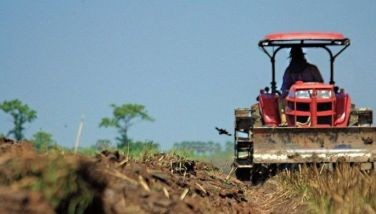Bagoong cubes, anyone?
February 5, 2006 | 12:00am
Here’s another exciting new product: Bagoong cubes.
A bagoong cube is a dried product of fish fermentation, one of the oldest technologies in fish preservation.
The novelty product, now in the market, especially in Cagayan Valley, was the offshoot of a study done by Dr. Carmencita L. Culasing of the Cagayan State University-College of Fisheries and Marine Science (CSU-CFMR) in Aparri, Cagayan.
It is now being promoted by the Northern Luzon Aquatic and Marine Research and Development Zonal Center (NLAMRD-ZC) based at the Don Mariano Marcos Memorial State University (DMMMSU) in Bacnotan, La Union. The NLAMRD-ZC is one of the zonal centers coordinated by the Los Baños-based Department of Science and Technology-Philippine Council for Aquatic and Marine Research and Development (DOST-PCAMRD) headed by Executive Director Rafael D. Guerrero III.
Samples of bagoong cubes were among the products exhibited at the first Aquatic Technology Competition and Marketplace (ATCOM) sponsored last Jan. 30 by DOST-PCAMRD. The ATCOM was one of the main activities during the observance of PCAMRD’s 18th anniversary last Jan. 30-31.
Bagoong is usually placed in bottles, which are heavy and delicate to handle. Marketing of the bottled product poses a problem in transporting because it requires a bigger space and demands higher fare rate.
The bagoong cubes, on other hand, are packed in cut rite, aluminum foil, and cartoon.
PCAMRD said the process of transforming bagoong into cubes is simple. It is prepared by separating the flesh from the bones of a fermented fish, dried, macerated (softened), and formed into cubes.
Laboratory panelists tapped to assess the study preferred the use of hairtail (espada) fish species as a raw material in making bagoong cubes because it gives a lighter brown color.
However, other fish species such as marine anchovies, freshwater anchovies, and roundsound (galunggong) were also found generally acceptable.
The optimum fermentation period is three months for smaller fish and five months for bigger ones.
Bagoong cubes have several advantages.
One, it provides additional livelihood opportunities for village people and even unemployed educated individuals.
The product is easier to handle and cheaper to transport. Moreover, it helps harried housewives to cook faster because of easier preparation.
The NLAMRD-ZC also said that the major potential hazard associated with proteinaceous foods in fermented fish is the growth of bacteria and toxin production of Clostridium botuinum because of the anaerobic (characterized by the absence of oxygen) and water content of the product.
"This technology eliminates the problem of the production of toxin by said bacteria," it averred. Also, bagoong cube is feasible throughout the year. – Rudy A. Fernandez
A bagoong cube is a dried product of fish fermentation, one of the oldest technologies in fish preservation.
The novelty product, now in the market, especially in Cagayan Valley, was the offshoot of a study done by Dr. Carmencita L. Culasing of the Cagayan State University-College of Fisheries and Marine Science (CSU-CFMR) in Aparri, Cagayan.
It is now being promoted by the Northern Luzon Aquatic and Marine Research and Development Zonal Center (NLAMRD-ZC) based at the Don Mariano Marcos Memorial State University (DMMMSU) in Bacnotan, La Union. The NLAMRD-ZC is one of the zonal centers coordinated by the Los Baños-based Department of Science and Technology-Philippine Council for Aquatic and Marine Research and Development (DOST-PCAMRD) headed by Executive Director Rafael D. Guerrero III.
Samples of bagoong cubes were among the products exhibited at the first Aquatic Technology Competition and Marketplace (ATCOM) sponsored last Jan. 30 by DOST-PCAMRD. The ATCOM was one of the main activities during the observance of PCAMRD’s 18th anniversary last Jan. 30-31.
Bagoong is usually placed in bottles, which are heavy and delicate to handle. Marketing of the bottled product poses a problem in transporting because it requires a bigger space and demands higher fare rate.
The bagoong cubes, on other hand, are packed in cut rite, aluminum foil, and cartoon.
PCAMRD said the process of transforming bagoong into cubes is simple. It is prepared by separating the flesh from the bones of a fermented fish, dried, macerated (softened), and formed into cubes.
Laboratory panelists tapped to assess the study preferred the use of hairtail (espada) fish species as a raw material in making bagoong cubes because it gives a lighter brown color.
However, other fish species such as marine anchovies, freshwater anchovies, and roundsound (galunggong) were also found generally acceptable.
The optimum fermentation period is three months for smaller fish and five months for bigger ones.
Bagoong cubes have several advantages.
One, it provides additional livelihood opportunities for village people and even unemployed educated individuals.
The product is easier to handle and cheaper to transport. Moreover, it helps harried housewives to cook faster because of easier preparation.
The NLAMRD-ZC also said that the major potential hazard associated with proteinaceous foods in fermented fish is the growth of bacteria and toxin production of Clostridium botuinum because of the anaerobic (characterized by the absence of oxygen) and water content of the product.
"This technology eliminates the problem of the production of toxin by said bacteria," it averred. Also, bagoong cube is feasible throughout the year. – Rudy A. Fernandez
BrandSpace Articles
<
>
- Latest
Latest
Latest
March 4, 2024 - 3:32pm
By Ian Laqui | March 4, 2024 - 3:32pm
March 4, 2024 - 2:12pm
By Kristine Daguno-Bersamina | March 4, 2024 - 2:12pm
February 17, 2024 - 2:31pm
February 17, 2024 - 2:31pm
February 13, 2024 - 7:24pm
By Gaea Katreena Cabico | February 13, 2024 - 7:24pm
February 13, 2024 - 7:17pm
By Ian Laqui | February 13, 2024 - 7:17pm
Recommended





























